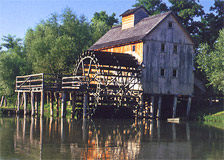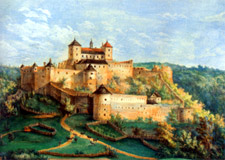Technical Monuments (Cultural Heritage of Slovakia)

Slovakia, although historically an agrarian country, is also rich in technical monuments. The country was no exception as far as the past developments in the sphere of technology and industries in Europe are concerned. Slovakia occupied an eminent position in the area of extraction and processing of ores. Technical monuments that survive here are the witnesses of not only the mining but also industrial production in general. Technical monuments perhaps belong to the most threatened type of monuments that are decaying literally in front of our eyes. In recent years, numerous technical monuments and their important parts, which were not even documented, disappeared. It also is the reason why this book was published. Its mission is to promote and support first the documentation of important and valuable monuments and eventually their conservation.
With regards to cultural and historic monuments and country's landmarks, technical monuments may not be as attractive but each of them enshrines a piece of history with its unique charm. They amount to several hundreds in Slovakia. Mills, water reservoirs, mines and bridges are the most abundantly represented. Many of them have become destinations or parts of tourist tracks. This book informs visitors about the technical monuments they may run into along their wanderings across Slovakia.
In two languages: Slovak, English.

Preview from the book
Riverbank pile mills on the river Maly Dunaj
In the 19th century, some millers reconstructed the boat mills on the Danube into riverbank pile mills and moved them to the Maly Dunaj (Little Danube). Anyway, the riverbank pile mills existed on almost all great European rivers in the past, above all in the cities. They gradually disappeared in modern time along with the development of river transport under the pressure of safety and hygienic measures. Surprisingly, they emerged again by the end of the 19th century on the Maly Dunaj.
The grinding plant of pile mills consists of the wooden frame encased by planks. They stand next to the bank on wooden pillars and the massive paddlewheel turns in the stream. The other end of the shaft rests on a supporting bench. The water stream was controlled by the weir. The gear system consisted of two pairs of cogged wheels. Wheels drove the runners on mill scaffold (the mill in Tomasikovo) and later other devices such as sieving or cleaning machines or mechanical lifts (paternosters)driven by bands over the gearing shaft (mills in Jelka and Jahodna) were added to them.
The grinding plant was originally one room with low ceiling. The miller observed the working of the water wheel or the arriving farmers with corn from the other riverbank. In such case he fetched the sacks with corn on this own boat. Narrow wooden footbridge was used for the contact with the riverbank. The simple structure of the mill is covered by shingle roof. This is how the preserved pile mill of Jan Maticza in Tomasikovo surviving in the beautiful natural nook at the confluence of rivers Maly Dunaj and Suchy potok looks like now. It was built in 1893; it worked until 1960 and was adapted in 1982. The restored mill has been made accessible as a museum exhibition called Nemethov mlyn v Jelke (Nemeth's mill in Jelka). In 1894, it was still registered as a boat mill but it was adapted to the pile mill in 1899 and its owner had it later modernized and enlarged. It was equipped with lifts and a chute for sacks. After the mill was destroyed, the communal authorities decided to reconstruct it in 1993 and established a museum in its area. The third conserved pile, mill on the Maly Dunaj is the mill in Jahodna. There were three more mills in this commune in the mid-20th century although they were quite modernized and rebuilt. One of them owned by Stefan Nagy was reconstructed in 1999. The hybrid mill in Dunajsky Klatov on the arm Klatovske rameno of the Maly Dunaj, is particularly interesting. The classical riverbank pile mil was modernized in 1920. The water wheel with the gear mechanism on piles was kept, but the owner built the bricked twostoried grinding plant on the riverbank. The compound also contains residential and auxiliary structures proper to the miller's homestead. The mill situated in a charming natural setting has been opened to public in 1987, as the exhibition dedicated to the milling craft.

Contents
Technical monuments in Slovakia 4
PRODUCTION MONUMENTS 11
Traditional technical monuments 12
Mills 13
Cajla – water wheel mill 14
Bohunice – water wheel mill 14
Water mill in Vrable 15
The Hutterite mill in Sobotiste 16
Water mills in the valley Kvacianska dolina 17
Boat mill in Kolarovo 18
Riverbank pile mills on the river Maly Dunaj 20
Holic – windmill 21
Smithies 23
Pottery 24
Blueprint workshop 26
Limekilns 27
Mining monuments 28
Mining monuments in Banska Stiavnica 29
Water managing system consisting of „tajchy“ 29
Galleries and hereditary galleries 30
Hereditary gallery Glanzenberg 30
Hereditary gallery Horny Biber 31
Hereditary gallery Svätotrojicna 31
Hereditary gallery Voznicka 31
Gallery Frantisek with a tower 32
The knocker 32
Technical monuments in Kremnica 33
Hereditary galleries 34
Mining tower Ferdinand 35
The Fourth gallery 35
The water pipe of Turcek 35
The knocker 37
Technical monuments in Spania Dolina 38
Mining tower of the pit Ludovika 38
Mining water pipe of Spania Dolina 39
The knocker 39
Salt works of Presov 40
Opal mine in Dubnik 42
Metallurgical monuments 44
Water hammer mills in Medzev 45
Tischler water hammer mill 46
The blast furnace in Cervenany 47
The blast furnace in Nizna Slana – Etelka huta 48
The blast furnace in Vlachovo – Karlova huta 49
The blast furnace in Osrblie-Tri Vody 49
The blast furnace in Podbiel – Frantiskova huta 50
Industrial monuments 52
Mint of Kremnica 54
Modra – ceramic manufacture 55
Faience in Holic 55
Glass factory in Lednicke Rovne 56
Mill and water tower in Trnava 58
Mill 58
Water tower 58
Industrial monuments in Bratislava 60
Bratislava thread factory 61
Storehouse No 7 (Winter Docks) 62
New gasworks at Mlynske Nivy 63
Monuments of the Bratislava water-supply 64
TECHNICAL MONUMENTS 67
Bridges 68
Wooden bridges 69
Stone bridges 70
Colonnade bridge in Piestany 72
Railway monuments 74
Forest railways 74
Back swath forest railway Vychylovka – Tanecnik 75
Ciernohronska forest railway Hronec – Cierny Balog 77
Ciernovazska forest railway in Pribylina 78
Railway monuments of the main railway network 79
Telgartska slucka (The loop of Telgart) 80
Cable way to the Lomnicky stit peak 81
Railway monuments of Bratislava 83
The horse railway station 83
The station of the steam railway 85
Warehouses I, II (Museum of Transport) 86
The Main station 86
Monuments of water management and energetics 88
Water reservoir Bacuch 89
Water reservoir Uhorna 89
Pumping station Patince 90
Small water power station Huncovce 91
Hydroelectric power station Ladce – Dolne Kockovce 93
Water tower in Komarno 95
Water power station in Lubochna 95
Steam power station in Poprad 96
SCIENTIFIC MONUMENTS 99
Scientific monuments 100
Astronomical observatory in Hurbanovo 101
Astronomical observatory at Skalnate pleso 102
Technical museums 104
Slovak Agricultural Museum Nitra 105
Slovak Technical Museum Kosice 106
Slovak Mining Museum Banska Stiavnica 107
Bibliography 142
More information:
 Series Cultural Heritage of Slovakia
Series Cultural Heritage of Slovakia
Published: 2008-01-30
Updated: 2008-01-30
Categories: - Historical Technique








